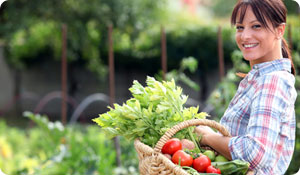
Fresh-grown foods have a significant edge over store-bought produce in terms of taste and nutrients, and there's a definite satisfaction in raising and eating your own plants. You can pick them at the height of ripeness when they're bursting with vitamins, and there's no worry about their being contaminated with pesticides or other pollutants. Best of all, you don't need nearly as much space as you think. But what should you grow?
Herbs. Because they're so small, herbs are a natural choice for space-challenged gardeners. In fact, all you need is one pot that's large enough for a few different herb varieties such as basil, sage, and thyme. Fill the pot with soil up to about three inches below the rim. Moisten it gently and mix the soil and water until it's slightly muddy but not sopping. Plant each herb with a few inches of space around it, then find a sunny spot and water the plants whenever they look tired. You can even keep the pot indoors on a windowsill if you don't have any outdoor space at all.
Vegetables. According to the Farmer's Almanac, almost any vegetable normally grown outdoors can be grown indoors in a container. Particularly well suited for containers are tomatoes, eggplants, cucumbers, peppers, lettuce, and spinach. Aim for nonporous containers such as those made from plastic or ceramic, as less water will leach out of them. As with herbs, vegetables do best in lots of sun and with frequent watering (not overwatering).
Hankering for a real patch of land to call your own? Explore becoming part of a community garden. Community gardens have surged in popularity in recent years in many areas, and are particularly sought out in inner cities where living space is at a premium and during lean times when supermarket produce may be out of reach. When you join a community garden, you rent a small plot of land to grow your own herbs and produce. Not only do you get the satisfaction of creating your own nutritious food for pennies, but community gardens reduce air pollution and draw neighbors together. To find a community garden near you, or for advice on how to start one, visit the American Community Gardening Association's website.
If you're committed to eating the freshest, most seasonal, locally grown produce possible but just don't have the time or inclination to tend a garden, look into community-supported agriculture (or CSA, in gardening parlance). When you buy a share in a CSA, you get regular deliveries of fresh food directly from a farm (or you go to the farm to put together your own box of produce). You get only fruits and vegetables that are in season, grown nearby, and are full of vitamins and flavor, all while supporting a local business.
Sources:
LocalHarvest. "Community Supported Agriculture." Web. www.localharvest.org/csa
Farmer's Almanac. "Grow Your Own Food in Small Spaces." Web. 5 May 2011. www.farmersalmanac.com/home-garden/2011/05/30/container-gardening/
Apartment Therapy. "How To Make a One-Pot Indoor Herb Garden." Web. www.apartmenttherapy.com/how-to-make-a-o-35198





